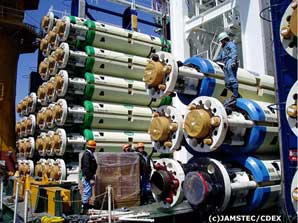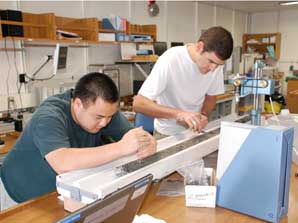Web Japan > Trends in Japan > Sci-tech > Unraveling the Riddles of the Deep
Unraveling the Riddles of the Deep
Japan Leading the World in Deep Earth Exploration

Chikyu’s Dynamic Positioning System. (C)Japan Agency for Marine-Earth Science and Technology
The Japanese deep-sea drilling vessel Chikyu (meaning "the earth" in Japanese) has a special mission: to drill the deepest hole ever, all the way down into the earth's mantle, far below the deepest seas. Chikyu is the first drilling boat of its kind ever to be developed for scientific research, and boasts the most advanced drilling technology in the world. Scientists are optimistic that research carried out by Chikyu will reveal new information about the mechanism of earthquakes, as well as discovering previously unknown deep-sea resources and life forms.
Advanced Drilling Technology from the Land of EarthquakesWhy does Japan experience so many earthquakes? The answer lies in the dozen or so huge blocks of solid earth called tectonic plates that lie beneath the surface of our planet. Movements of the mantle that lies beneath the earth's crust cause the plates to move against each other at a rate of several centimeters a year, banging into or subsiding underneath each other. The influence of this is particularly strong at points where two or more plates meet. This is what causes earthquakes and volcanic activity. Japan experiences so many earthquakes because of its very unusual geographical situation: There are four tectonic plates that affect Japan, and they all meet underneath the Japanese archipelago.
One of the main motivations for building Chikyu was to drill a deep hole through to the earth's mantle. Scientists hope that by learning more about what goes on in the mantle, they will get a better understanding of how earthquakes happen. Researchers decided to start drilling from the seabed, since the earth's crust is thinner there than on land and the distances involved are shorter.

Riser pipes on deck ready for use. (C)Japan Agency for Marine-Earth Science and Technology
Enlarge photoReaching the Mantle with Japan's Most Advanced TechnologyIn fact, many other difficulties come into play when drilling in the sea instead of on land. To drill under the sea, you need to extend a pipe from a ship on the surface to depths of more than a kilometer. Waves and currents make it extremely difficult to maintain the ship in a steady position. To overcome this problem, the Japan Agency for Marine-Earth Science and Technology developed a highly advanced dynamic positioning system. Even the slightest shift in the ship's position on the ocean's surface can damage the pipes connecting the ship to the sea floor, so the vessel needs to be held in a steady position relative to the sea floor at all times. The ship's position is constantly monitored by GPS data and echolocating transponders placed on the seabed. By measuring the shifting movements of the ship caused by wind, currents, and waves, the positioning system uses six azimuth thrusters (propellers that can be rotated freely through 360 degrees) on the bottom of the ship's hull to help maintain Chikyu's position at all times.
An even bigger challenger when drilling underwater is the need to keep extending the pipe little by little as drilling progresses. To clear this hurdle, Chikyu uses a two-layered system, in which the drill pipe is contained inside the riser pipes, a series of connected perpendicular pipes that joins the hull of the ship to the ocean floor. Liquid circulating between them prevents the hole from collapsing under pressure from the sediments and rock as it is drilled. At the same time, the liquid carries excavated earth to the surface and helps to keep the drill bit cool. This kind of technology was previously used on oil drilling ships, but the Japanese team improved the technology to enable them to insert research tools inside the drill. Their work resulted in the first technology in the world to used deep-sea drilling for scientific research. Thanks to this revolutionary Japanese technology, Chikyu now has everything it will need to drill down to the mantle from a starting point some 4,000 meters under the sea. The mantle itself lies at least 7,000 meters below sea level. This technology will allow Chikyu to take samples for research from deep-earth levels far beneath the world’s deepest oceans.

Researchers carrying out analysis on board.
(C)Japan Agency for Marine-Earth Science and Technology
The Mantle Mission: A World FirstSince its first expedition in 2007, Chikyu has carried out five drilling missions in the Nankai Trough seismogenic zone, reaching a depth of 1,600 meters beneath the seabed.
From 2010, Chikyu is scheduled to carry out drilling expeditions at the Nankai Trough, the Okinawa Trough, and off the Shimokita Peninsula. In the sixth Nankai Trough expedition, Chikyu will drill and place the first of many Long-Term Borehole Monitoring Systems. In the Okinawa Trough, Chikyu will carry out research on the microorganisms that live in hydrothermal vents and deposits beneath the ocean floor. Off the Shimokita Peninsula, Chikyu will drill a hole reaching 2,500 meters below the seabed (itself 1,200 meters under the surface) in order to study the life of methane-producing bacteria present in lignite layers beneath the ocean.
“Even at its closest point, the mantle lies at least 7,000 meters beneath the seabed,” explains Azuma Wataru, head of the Center for Deep Earth Exploration in the Japan Agency for Marine-Earth Science and Technology. “In addition to highly precise project planning, improvements in the engineering and operations technology used in drilling will also be essential. There are still many obstacles to overcome before we reach the mantle, but it’s a goal we are moving toward slowly but surely, one step at a time.”
Specimens taken from inside the earth’s mantle will help us gain a better understanding of the mechanisms of change in the global environment. Researchers hope that Chikyu will help to solve some of the biggest mysteries of geology in the years to come. (November 2010)
- Deeper Than Ever (September 2006)

